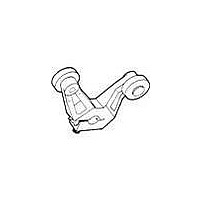LSZ53U Honeywell, LSZ53U Datasheet - Page 120

LSZ53U
Manufacturer Part Number
LSZ53U
Description
Switch Hardware Limit Switch Receptacles for HDLS
Manufacturer
Honeywell
Datasheet
1.LSZ53U.pdf
(148 pages)
Specifications of LSZ53U
Lead Free Status / RoHS Status
Compliant
ULTRASONIC DISTANCE SENSORS
Figure 2: Effect of target inclination on the measurement
Environmental influences
The velocity of sound in air is temperature-dependent, and increases at a rate
of 0.18 %/°C. Honeywell ultrasonic distance sensors have their own
temperature transducer, which adjusts both the clock frequency of the elapsed
time counter and the carrier frequency. Major temperature fluctuations within
the measuring path can, however, lead to sound dispersion and refraction,
which disturb the measuring result and limit the stability of the measurement
(Figure 3). Air streams, turbulence and air layers of different densities can, in
certain conditions, attenuate or deflect the echo to such an extent that the
sensor cannot detect it. On the other hand, air humidity and normal
atmospheric air pressure fluctuations have virtually no influence on the
measurements.
Figure 3: Effect of warm air turbulence on the measurement
Repeatability
All information concerning repeatability and hysteresis in this data sheet is
valid for axial target movements (Figure 4). If a target approaches the sensor
from a distance, the output switches at the set value ± the given repeatability.
If the target moves further away from the sensor, the output switches back
into its original condition, at a distance which is equal to the sum of the
setpoint and the given hysteresis ± the repeatability. If a target moves laterally
into the acoustic beam, the echo energy increases. If the measurement
threshold of the sensor is reached, the output becomes active. This threshold
depends on the target properties and its distance from the sensor. The
position can only be determined experimentally.
118
Sn
Sn
Sn
Sn
< 5°
< 5°
< 5°
< 5°
warm
www.honeywell.com/sensing
cold
10 cm
10 cm
10 cm
10 cm
10 cm
10 cm
10 cm
10 cm
Figure 4: Repeatability and hysteresis
Mutual interference
Despite pulse coding, if several sensors are used simultaneously in a single
application, mutual interference can occur. This phenomenon will, however,
only arise if, as a result of the inclination of the object, or the positioning of
two sensors opposite one another, false echo signals can be received. By
using the inhibitor input, maintaining minimum distances or restricting the
beam angle with a focusing reflector, the problem can be almost entirely
avoided.
Synchronisation
The majority of Honeywell ultrasonic distance sensors can be very easily
synchronised by interconnecting the appropriate inputs or connecting them
with an external synchronisation unit. The transmission of the acoustic pulses
then occurs simultaneously. This makes it possible to use the sensors for
applications in which the ultrasonic transducers are facing each other, while
still avoiding mutual interference.
Protective measures
All sensors are protected against water and dust, according to the DIN
standard IP 65. The transducer is coated with silicone rubber or epoxy, but it
can be attacked by aggressive acid or caustic atmospheres. It is also
necessary to ensure that the transducer face remains clear of liquid or solid
deposits, which could limit the performance of the sensor. Drops of water may
be deposited on the transducer surface, as a result of condensation. These
could severely reduce the sensor range. Also because of the risk of icing up,
and because sensors detect raindrops, the suitability of these sensors for
outdoor use, despite the protective measures, is limited.
Electrical interference
All Honeywell ultrasonic sensors are protected against reverse polarity, short
circuits, overloads and voltage spikes. Special protective circuitry makes the
sensor almost entirely immune to electromagnetic and radio frequency
interference. However, unstable measurements may arise if the sensor is
placed in the vicinity of strong electrical fields. In such cases, the
interconnection cables should be screened as far as possible, or separated
from power cables. The use of regulated power supplies with mains filters,
and limiting the maximum cable length to 50 metres can also offer possible
solutions. All sensors are CE marked.
Alignment aid
The majority of Honeywell ultrasonic distance sensors have an LED, the
output intensity of which is proportional to the ultrasonic echo received. The
brighter the LED, the better aligned the sensor.
Please contact your nearest Honeywell office for details of other models
available.
(cm)
-1
-3
-5
5
3
1
0
Output
200
Hysteresis
400
600
Switching point in
backwards direction
800
Repeatability
Switching point in
forwards direction
1000
1200
Target
1400 (mm)


















